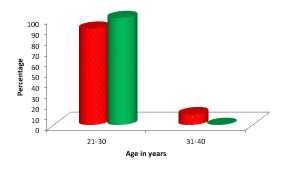Comparative Study of Percutaneous Electrical Nerve Stimulation versus Transcutaneous Electrical Nerve Stimulation on Trigger Points in Levator Scapulae Muscle.
Main Article Content
Abstract
Myofascial pain syndrome can be defined as motor, sensory and autonomic symptoms that cause Myofascial trigger points (MTrP). These are hyperirritable areas in skeletal muscle associated with hypersensitive nodule in a taut band. Trigger Points causes shortening of muscles often compress adjacent nerves. This irritates the nerve and disturbs the signal transmission system of nerves. This leads to irregular sensations, causing numbness, tingling, and burning. Present study was undertaken to find out the effectiveness of Percutaneous Electrical Nerve Stimulation (PENS) Vs. Transcutaneous Electrical Nerve Stimulation (TENS) for treating MTrP. Experimental study was conducted with 60 participants fulfilling inclusion and exclusion criteria. Informed consent was taken from the subjects. PENS was administered in Group B and TENS therapy was administered to Group A for a period of 3 weeks, 3 sessions per week. Pre on Day 1 and post on Day 9th assessments were taken by using Pressure Algometer and Range of motion by Universal Goniometer . Vitamin C supplement was recommended prior to the treatment for patients who were treated with PENS for post needle soreness and rapid healing.The outcome of Pressure Algometer and ROM were statistically analyzed. It was found to be effective with P value<0.000.. There was significant decrease in pain recorded in Numerical Pain Rating Scale NPRS and increased in Pain Pressure threshold in patients treated in both the groups. Statistically both the Groups are competent enough to alleviate pain but clinically PENS showed better response in pain depletion and functional mobility compared to TENS .
Article Details
References
Joanne Borg- Stein, MD David G. Simons, MD, Myofascial Pain, Arch Phys Med Rehabil 2002; 83 (1) 40-45
Dimitris K. and Konstantina R, the Manual of Trigger Point and Myofascial Therapy Slack incorporate, 1st edition, 2001.
Elizabeth Demers Lavelle, MD, William Lavelle, MD, Howard S Smith, MD, FACP Myofascial trigger points 2007; 841-851
Hugh Gemmell, Axel Hilland, Journal of bodywork and movement therapies 15 (3), 348-354, 2001. Immediate effect of electrical point stimulation (TENS) in treating latent double-blind randomized placebo- controlled trial.
EK Chee, Walton, Journal of manipulative and physiological therapeutics 9(2), 131-134, 1986. Treatment of trigger points with microampere transcutaneous electrical nerve stimulation (TENS)
Steven B Graff-Radford, John L Reeves, Robert L Baker, Daryl Chiu, Pain 37 (1), 1-5, 1989. Effect of Transcutaneous electrical nerve stimulation on myofascial.
MOHAMED A. HAMZA, MD PAUL F. WHITE, PHD, MD, FANZCA WILLIAM F. CRAIG, MD Percutaneous Electrical Nerve Stimulation A novel analgesic therapy for diabetic neuropathic pain, Emerging Treatments and Technologies, DIABETES CARE, VOLUME 23, NUMBER 3, MARCH 2000
El-Sayed A. Ghoname, Paul F. White, Hesham E. Ahmed, Mohamed A. Hamza, William F. Craig, Carl E. Noe, Percutaneous electrical nerve stimulation: an alternative to TENS in the management of sciatica, International Association for the Study of Pain. Published by Elsevier Science B.V, Pain 83 (1999) 193+199
Dry needling (intramuscular stimulation) in myofascial pain related tolumbosacralradiculopathy. Chu J 1995, European Journal of Physical Medicine & Rehab 5(4):106-121

